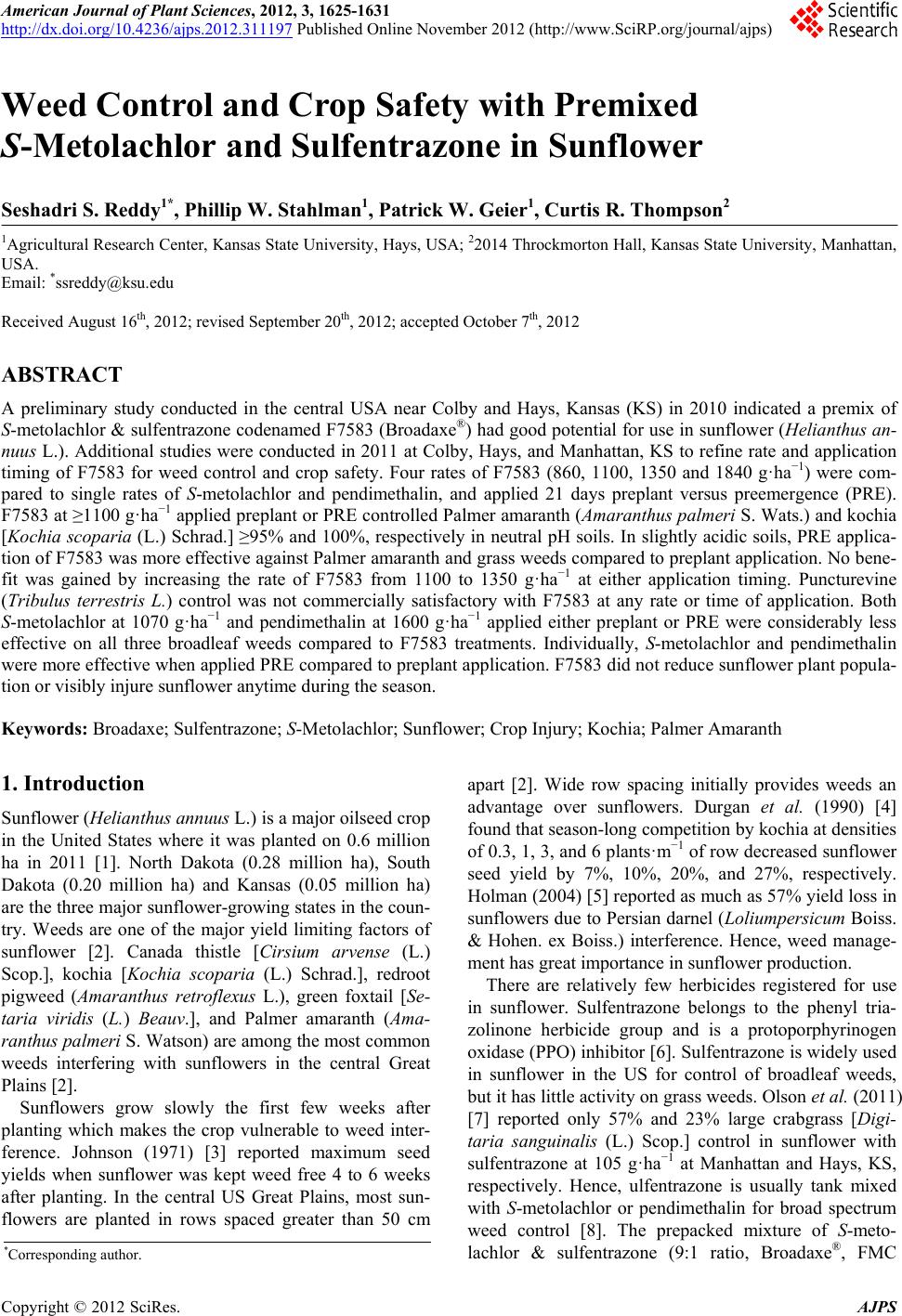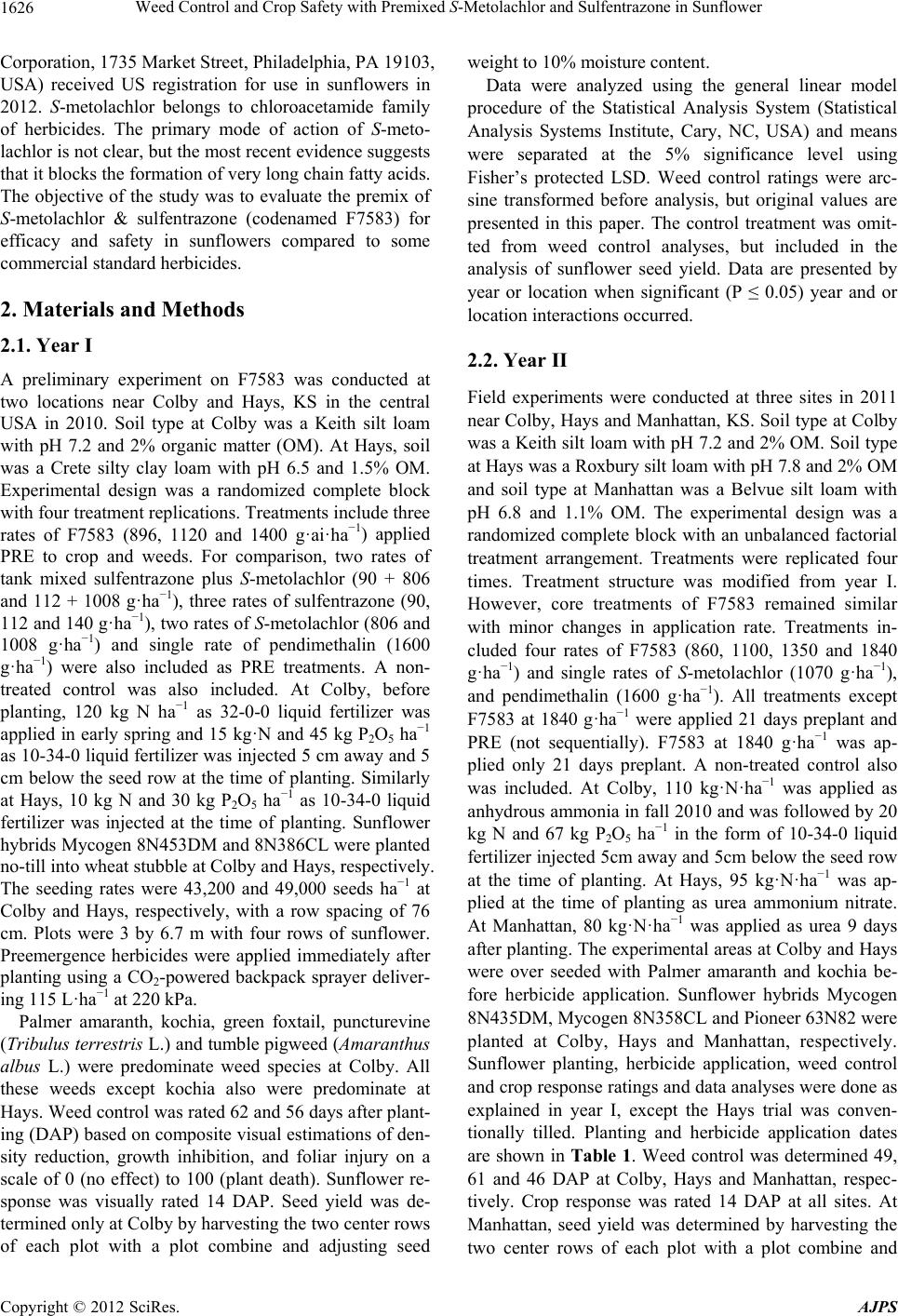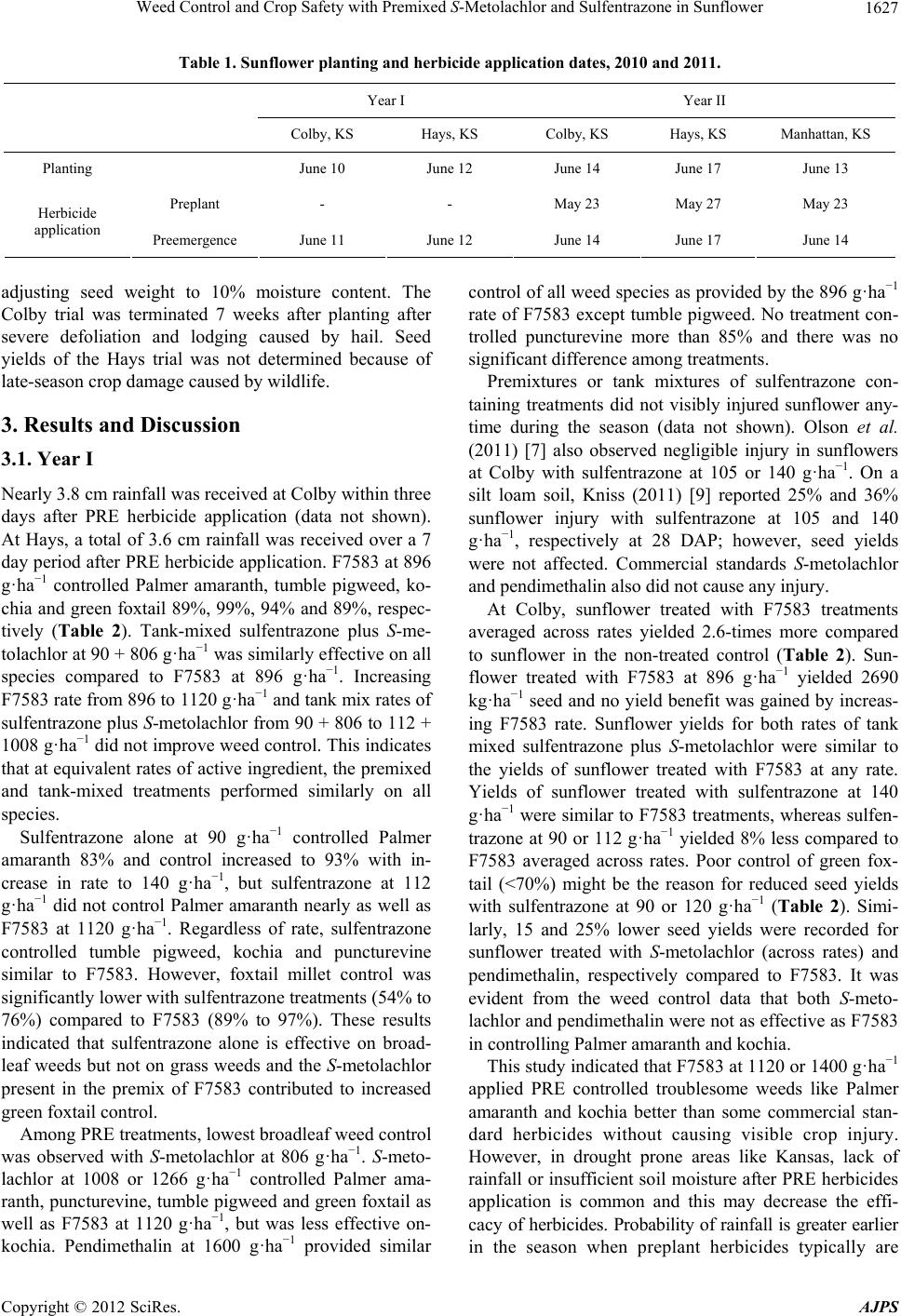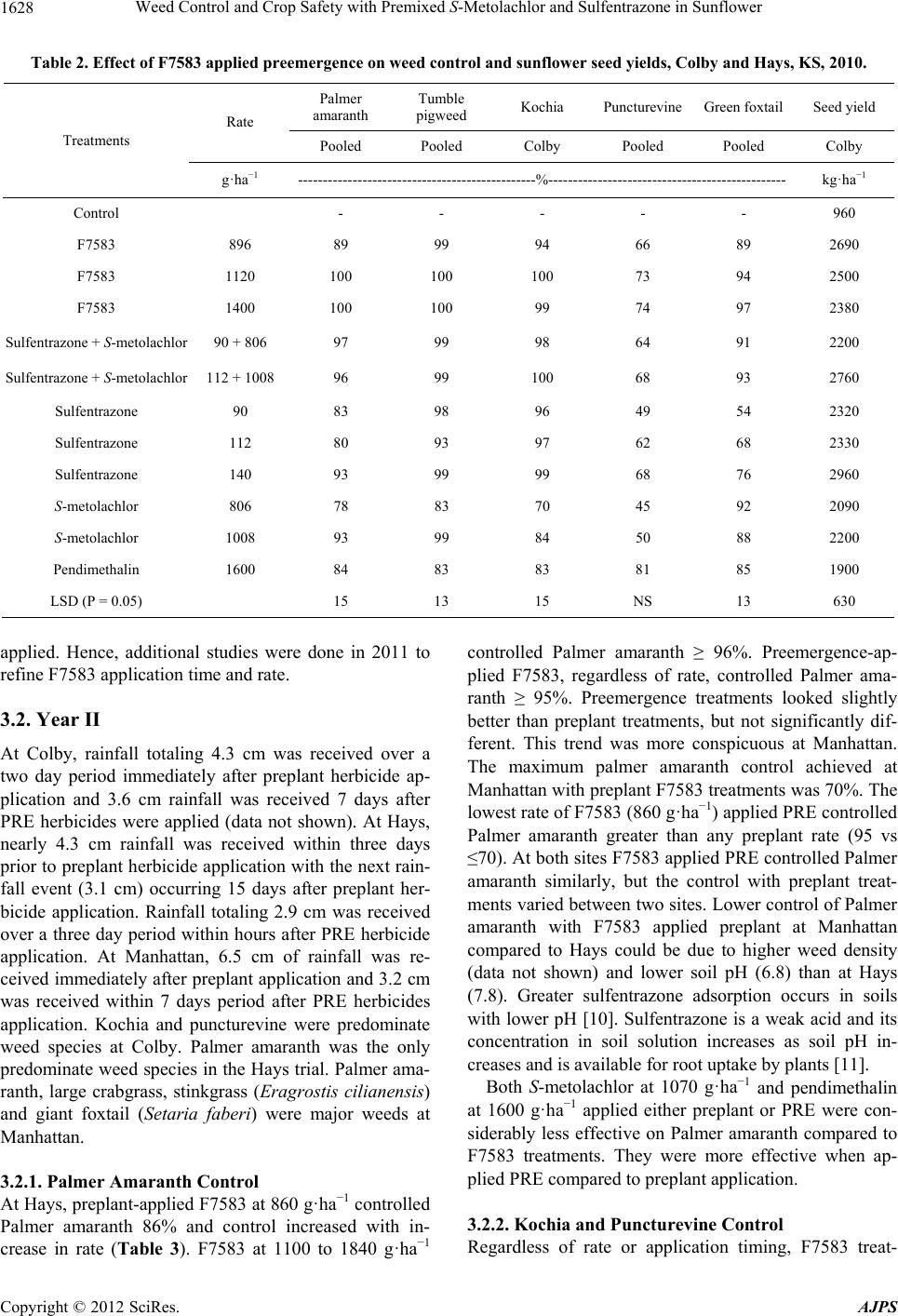Paper Menu >>
Journal Menu >>
 American Journal of Plant Sciences, 2012, 3, 1625-1631 http://dx.doi.org/10.4236/ajps.2012.311197 Published Online November 2012 (http://www.SciRP.org/journal/ajps) 1625 Weed Control and Crop Safety with Premixed S-Metolachlor and Sulfentrazone in Sunflower Seshadri S. Reddy1*, Phillip W. Stahlman1, Patrick W. Geier1, Curtis R. Thompson2 1Agricultural Research Center, Kansas State University, Hays, USA; 22014 Throckmorton Hall, Kansas State University, Manhattan, USA. Email: *ssreddy@ksu.edu Received August 16th, 2012; revised September 20th, 2012; accepted October 7th, 2012 ABSTRACT A preliminary study conducted in the central USA near Colby and Hays, Kansas (KS) in 2010 indicated a premix of S-metolachlor & sulfentrazone codenamed F7583 (Broadaxe®) had good potential for use in sunflower (Helianthus an- nuus L.). Additional studies were conducted in 2011 at Colby, Hays, and Manhattan, KS to refine rate and application timing of F7583 for weed control and crop safety. Four rates of F7583 (860, 1100, 1350 and 1840 g·ha−1) were com- pared to single rates of S-metolachlor and pendimethalin, and applied 21 days preplant versus preemergence (PRE). F7583 at ≥1100 g·ha−1 applied preplant or PRE controlled Palmer amaranth (Amaranthus palmeri S. Wats.) and kochia [Kochia scoparia (L.) Schrad.] ≥95% and 100%, respectively in neutral pH soils. In slightly acidic soils, PRE applica- tion of F7583 was more effective against Palmer amaranth and grass weeds compared to preplant application. No bene- fit was gained by increasing the rate of F7583 from 1100 to 1350 g·ha−1 at either application timing. Puncturevine (Tribulus terrestris L.) control was not commercially satisfactory with F7583 at any rate or time of application. Both S-metolachlor at 1070 g·ha−1 and pendimethalin at 1600 g·ha−1 applied either preplant or PRE were considerably less effective on all three broadleaf weeds compared to F7583 treatments. Individually, S-metolachlor and pendimethalin were more effective when applied PRE compared to preplant application. F7583 did not reduce sunflower plant popula- tion or visibly injure sunflower anytime during the season. Keywords: Broadaxe; Sulfentrazone; S-Metolachlor; Sunflower; Crop Injury; Kochia; Palmer Amaranth 1. Introduction Sunflower (Helianthus annuus L.) is a major oilseed crop in the United States where it was planted on 0.6 million ha in 2011 [1]. North Dakota (0.28 million ha), South Dakota (0.20 million ha) and Kansas (0.05 million ha) are the three major sunflower-growing states in the coun- try. Weeds are one of the major yield limiting factors of sunflower [2]. Canada thistle [Cirsium arvense (L.) Scop.], kochia [Kochia scoparia (L.) Schrad.], redroot pigweed (Amaranthus retroflexus L.), green foxtail [Se- taria viridis (L.) Beauv.], and Palmer amaranth (Ama- ranthus palmeri S. Watson) are among the most common weeds interfering with sunflowers in the central Great Plains [2]. Sunflowers grow slowly the first few weeks after planting which makes the crop vulnerable to weed inter- ference. Johnson (1971) [3] reported maximum seed yields when sunflower was kept weed free 4 to 6 weeks after planting. In the central US Great Plains, most sun- flowers are planted in rows spaced greater than 50 cm apart [2]. Wide row spacing initially provides weeds an advantage over sunflowers. Durgan et al. (1990) [4] found that season-long competition by kochia at densities of 0.3, 1, 3, and 6 plants·m−1 of row decreased sunflower seed yield by 7%, 10%, 20%, and 27%, respectively. Holman (2004) [5] reported as much as 57% yield loss in sunflowers due to Persian darnel (Loliumpersicum Boiss. & Hohen. ex Boiss.) interference. Hence, weed manage- ment has great importance in sunflower production. There are relatively few herbicides registered for use in sunflower. Sulfentrazone belongs to the phenyl tria- zolinone herbicide group and is a protoporphyrinogen oxidase (PPO) inhibitor [6]. Sulfentrazone is widely used in sunflower in the US for control of broadleaf weeds, but it has little activity on grass weeds. Olson et al. (2011) [7] reported only 57% and 23% large crabgrass [Digi- taria sanguinalis (L.) Scop.] control in sunflower with sulfentrazone at 105 g·ha−1 at Manhattan and Hays, KS, respectively. Hence, ulfentrazone is usually tank mixed with S-metolachlor or pendimethalin for broad spectrum weed control [8]. The prepacked mixture of S-meto- lachlor & sulfentrazone (9:1 ratio, Broadaxe®, FMC *Corresponding author. Copyright © 2012 SciRes. AJPS  Weed Control and Crop Safety with Premixed S-Metolachlor and Sulfentrazone in Sunflower 1626 Corporation, 1735 Market Street, Philadelphia, PA 19103, USA) received US registration for use in sunflowers in 2012. S-metolachlor belongs to chloroacetamide family of herbicides. The primary mode of action of S-meto- lachlor is not clear, but the most recent evidence suggests that it blocks the formation of very long chain fatty acids. The objective of the study was to evaluate the premix of S-metolachlor & sulfentrazone (codenamed F7583) for efficacy and safety in sunflowers compared to some commercial standard herbicides. 2. Materials and Methods 2.1. Year I A preliminary experiment on F7583 was conducted at two locations near Colby and Hays, KS in the central USA in 2010. Soil type at Colby was a Keith silt loam with pH 7.2 and 2% organic matter (OM). At Hays, soil was a Crete silty clay loam with pH 6.5 and 1.5% OM. Experimental design was a randomized complete block with four treatment replications. Treatments include three rates of F7583 (896, 1120 and 1400 g·ai·ha−1) applied PRE to crop and weeds. For comparison, two rates of tank mixed sulfentrazone plus S-metolachlor (90 + 806 and 112 + 1008 g·ha−1), three rates of sulfentrazone (90, 112 and 140 g·ha−1), two rates of S-metolachlor (806 and 1008 g·ha−1) and single rate of pendimethalin (1600 g·ha−1) were also included as PRE treatments. A non- treated control was also included. At Colby, before planting, 120 kg N ha−1 as 32-0-0 liquid fertilizer was applied in early spring and 15 kg·N and 45 kg P2O5 ha−1 as 10-34-0 liquid fertilizer was injected 5 cm away and 5 cm below the seed row at the time of planting. Similarly at Hays, 10 kg N and 30 kg P2O5 ha−1 as 10-34-0 liquid fertilizer was injected at the time of planting. Sunflower hybrids Mycogen 8N453DM and 8N386CL were planted no-till into wheat stubble at Colby and Hays, respectively. The seeding rates were 43,200 and 49,000 seeds ha−1 at Colby and Hays, respectively, with a row spacing of 76 cm. Plots were 3 by 6.7 m with four rows of sunflower. Preemergence herbicides were applied immediately after planting using a CO2-powered backpack sprayer deliver- ing 115 L·ha−1 at 220 kPa. Palmer amaranth, kochia, green foxtail, puncturevine (Tribulus terrestris L.) and tumble pigweed (Amaranthus albus L.) were predominate weed species at Colby. All these weeds except kochia also were predominate at Hays. Weed control was rated 62 and 56 days after plant- ing (DAP) based on composite visual estimations of den- sity reduction, growth inhibition, and foliar injury on a scale of 0 (no effect) to 100 (plant death). Sunflower re- sponse was visually rated 14 DAP. Seed yield was de- termined only at Colby by harvesting the two center rows of each plot with a plot combine and adjusting seed weight to 10% moisture content. Data were analyzed using the general linear model procedure of the Statistical Analysis System (Statistical Analysis Systems Institute, Cary, NC, USA) and means were separated at the 5% significance level using Fisher’s protected LSD. Weed control ratings were arc- sine transformed before analysis, but original values are presented in this paper. The control treatment was omit- ted from weed control analyses, but included in the analysis of sunflower seed yield. Data are presented by year or location when significant (P ≤ 0.05) year and or location interactions occurred. 2.2. Year II Field experiments were conducted at three sites in 2011 near Colby, Hays and Manhattan, KS. Soil type at Colby was a Keith silt loam with pH 7.2 and 2% OM. Soil type at Hays was a Roxbury silt loam with pH 7.8 and 2% OM and soil type at Manhattan was a Belvue silt loam with pH 6.8 and 1.1% OM. The experimental design was a randomized complete block with an unbalanced factorial treatment arrangement. Treatments were replicated four times. Treatment structure was modified from year I. However, core treatments of F7583 remained similar with minor changes in application rate. Treatments in- cluded four rates of F7583 (860, 1100, 1350 and 1840 g·ha−1) and single rates of S-metolachlor (1070 g·ha−1), and pendimethalin (1600 g·ha−1). All treatments except F7583 at 1840 g·ha−1 were applied 21 days preplant and PRE (not sequentially). F7583 at 1840 g·ha−1 was ap- plied only 21 days preplant. A non-treated control also was included. At Colby, 110 kg·N·ha−1 was applied as anhydrous ammonia in fall 2010 and was followed by 20 kg N and 67 kg P2O5 ha−1 in the form of 10-34-0 liquid fertilizer injected 5cm away and 5cm below the seed row at the time of planting. At Hays, 95 kg·N·ha−1 was ap- plied at the time of planting as urea ammonium nitrate. At Manhattan, 80 kg·N·ha−1 was applied as urea 9 days after planting. The experimental areas at Colby and Hays were over seeded with Palmer amaranth and kochia be- fore herbicide application. Sunflower hybrids Mycogen 8N435DM, Mycogen 8N358CL and Pioneer 63N82 were planted at Colby, Hays and Manhattan, respectively. Sunflower planting, herbicide application, weed control and crop response ratings and data analyses were done as explained in year I, except the Hays trial was conven- tionally tilled. Planting and herbicide application dates are shown in Table 1. Weed control was determined 49, 61 and 46 DAP at Colby, Hays and Manhattan, respec- tively. Crop response was rated 14 DAP at all sites. At Manhattan, seed yield was determined by harvesting the two center rows of each plt with a plot combine and o Copyright © 2012 SciRes. AJPS  Weed Control and Crop Safety with Premixed S-Metolachlor and Sulfentrazone in Sunflower Copyright © 2012 SciRes. AJPS 1627 Table 1. Sunflower planting and herbicide application dates, 2010 and 2011. Year IYear II Colby, KSHays, KSColby, KSHays, KSManhattan, KS Planting June 10June 12June 14June 17June 13 Preplant--May 23May 27May 23 Herbicide applicationPreemergenceJune 11June 12June 14June 17June 14 adjusting seed weight to 10% moisture content. The Colby trial was terminated 7 weeks after planting after severe defoliation and lodging caused by hail. Seed yields of the Hays trial was not determined because of late-season crop damage caused by wildlife. 3. Results and Discussion 3.1. Year I Nearly 3.8 cm rainfall was received at Colby within three days after PRE herbicide application (data not shown). At Hays, a total of 3.6 cm rainfall was received over a 7 day period after PRE herbicide application. F7583 at 896 g·ha−1 controlled Palmer amaranth, tumble pigweed, ko- chia and green foxtail 89%, 99%, 94% and 89%, respec- tively (Table 2). Tank-mixed sulfentrazone plus S-me- tolachlor at 90 + 806 g·ha−1 was similarly effective on all species compared to F7583 at 896 g·ha−1. Increasing F7583 rate from 896 to 1120 g·ha−1 and tank mix rates of sulfentrazone plus S-metolachlor from 90 + 806 to 112 + 1008 g·ha−1 did not improve weed control. This indicates that at equivalent rates of active ingredient, the premixed and tank-mixed treatments performed similarly on all species. Sulfentrazone alone at 90 g·ha−1 controlled Palmer amaranth 83% and control increased to 93% with in- crease in rate to 140 g·ha−1, but sulfentrazone at 112 g·ha−1 did not control Palmer amaranth nearly as well as F7583 at 1120 g·ha−1. Regardless of rate, sulfentrazone controlled tumble pigweed, kochia and puncturevine similar to F7583. However, foxtail millet control was significantly lower with sulfentrazone treatments (54% to 76%) compared to F7583 (89% to 97%). These results indicated that sulfentrazone alone is effective on broad- leaf weeds but not on grass weeds and the S-metolachlor present in the premix of F7583 contributed to increased green foxtail control. Among PRE treatments, lowest broadleaf weed control was observed with S-metolachlor at 806 g·ha−1. S-meto- lachlor at 1008 or 1266 g·ha−1 controlled Palmer ama- ranth, puncturevine, tumble pigweed and green foxtail as well as F7583 at 1120 g·ha−1, but was less effective on- kochia. Pendimethalin at 1600 g·ha−1 provided similar control of all weed species as provided by the 896 g·ha−1 rate of F7583 except tumble pigweed. No treatment con- trolled puncturevine more than 85% and there was no significant difference among treatments. Premixtures or tank mixtures of sulfentrazone con- taining treatments did not visibly injured sunflower any- time during the season (data not shown). Olson et al. (2011) [7] also observed negligible injury in sunflowers at Colby with sulfentrazone at 105 or 140 g·ha−1. On a silt loam soil, Kniss (2011) [9] reported 25% and 36% sunflower injury with sulfentrazone at 105 and 140 g·ha−1, respectively at 28 DAP; however, seed yields were not affected. Commercial standards S-metolachlor and pendimethalin also did not cause any injury. At Colby, sunflower treated with F7583 treatments averaged across rates yielded 2.6-times more compared to sunflower in the non-treated control (Table 2). Sun- flower treated with F7583 at 896 g·ha−1 yielded 2690 kg·ha−1 seed and no yield benefit was gained by increas- ing F7583 rate. Sunflower yields for both rates of tank mixed sulfentrazone plus S-metolachlor were similar to the yields of sunflower treated with F7583 at any rate. Yields of sunflower treated with sulfentrazone at 140 g·ha−1 were similar to F7583 treatments, whereas sulfen- trazone at 90 or 112 g·ha−1 yielded 8% less compared to F7583 averaged across rates. Poor control of green fox- tail (<70%) might be the reason for reduced seed yields with sulfentrazone at 90 or 120 g·ha−1 (Table 2). Simi- larly, 15 and 25% lower seed yields were recorded for sunflower treated with S-metolachlor (across rates) and pendimethalin, respectively compared to F7583. It was evident from the weed control data that both S-meto- lachlor and pendimethalin were not as effective as F7583 in controlling Palmer amaranth and kochia. This study indicated that F7583 at 1120 or 1400 g·ha−1 applied PRE controlled troublesome weeds like Palmer amaranth and kochia better than some commercial stan- dard herbicides without causing visible crop injury. However, in drought prone areas like Kansas, lack of rainfall or insufficient soil moisture after PRE herbicides application is common and this may decrease the effi- cacy of herbicides. Probability of rainfall is greater earlier in the season when preplan herbicides typically are t  Weed Control and Crop Safety with Premixed S-Metolachlor and Sulfentrazone in Sunflower 1628 Table 2. Effect of F7583 applied preemergence on weed control and sunflower seed yields, Colby and Hays, KS, 2010. Palmer amaranth Tumble pigweed Kochia Puncturevine Green foxtail Seed yield Rate Pooled Pooled Colby Pooled Pooled Colby Treatments g·ha−1 ------------------------------------------------%------------------------------------------------ kg·ha−1 Control - - - - - 960 F7583 896 89 99 94 66 89 2690 F7583 1120 100 100 100 73 94 2500 F7583 1400 100 100 99 74 97 2380 Sulfentrazone + S-metolachlor 90 + 806 97 99 98 64 91 2200 Sulfentrazone + S-metolachlor 112 + 1008 96 99 100 68 93 2760 Sulfentrazone 90 83 98 96 49 54 2320 Sulfentrazone 112 80 93 97 62 68 2330 Sulfentrazone 140 93 99 99 68 76 2960 S-metolachlor 806 78 83 70 45 92 2090 S-metolachlor 1008 93 99 84 50 88 2200 Pendimethalin 1600 84 83 83 81 85 1900 LSD (P = 0.05) 15 13 15 NS 13 630 applied. Hence, additional studies were done in 2011 to refine F7583 application time and rate. 3.2. Year II At Colby, rainfall totaling 4.3 cm was received over a two day period immediately after preplant herbicide ap- plication and 3.6 cm rainfall was received 7 days after PRE herbicides were applied (data not shown). At Hays, nearly 4.3 cm rainfall was received within three days prior to preplant herbicide application with the next rain- fall event (3.1 cm) occurring 15 days after preplant her- bicide application. Rainfall totaling 2.9 cm was received over a three day period within hours after PRE herbicide application. At Manhattan, 6.5 cm of rainfall was re- ceived immediately after preplant application and 3.2 cm was received within 7 days period after PRE herbicides application. Kochia and puncturevine were predominate weed species at Colby. Palmer amaranth was the only predominate weed species in the Hays trial. Palmer ama- ranth, large crabgrass, stinkgrass (Eragrostis cilianensis) and giant foxtail (Setaria faberi) were major weeds at Manhattan. 3.2.1. Palmer Amaranth Control At Hays, preplant-applied F7583 at 860 g·ha−1 controlled Palmer amaranth 86% and control increased with in- crease in rate (Table 3). F7583 at 1100 to 1840 g·ha−1 controlled Palmer amaranth ≥ 96%. Preemergence-ap- plied F7583, regardless of rate, controlled Palmer ama- ranth ≥ 95%. Preemergence treatments looked slightly better than preplant treatments, but not significantly dif- ferent. This trend was more conspicuous at Manhattan. The maximum palmer amaranth control achieved at Manhattan with preplant F7583 treatments was 70%. The lowest rate of F7583 (860 g·ha−1) applied PRE controlled Palmer amaranth greater than any preplant rate (95 vs ≤70). At both sites F7583 applied PRE controlled Palmer amaranth similarly, but the control with preplant treat- ments varied between two sites. Lower control of Palmer amaranth with F7583 applied preplant at Manhattan compared to Hays could be due to higher weed density (data not shown) and lower soil pH (6.8) than at Hays (7.8). Greater sulfentrazone adsorption occurs in soils with lower pH [10]. Sulfentrazone is a weak acid and its concentration in soil solution increases as soil pH in- creases and is available for root uptake by plants [11]. Both S-metolachlor at 1070 g·ha−1 and pendimethalin at 1600 g·ha−1 applied either preplant or PRE were con- siderably less effective on Palmer amaranth compared to F7583 treatments. They were more effective when ap- plied PRE compared to preplant application. 3.2.2. Kochia and Puncture v i n e Control Regardless of rate or appliation timing, F7583 treat- c Copyright © 2012 SciRes. AJPS  Weed Control and Crop Safety with Premixed S-Metolachlor and Sulfentrazone in Sunflower 1629 Table 3. Effect of F7583 applied 21 days preplant (DPP) or preemergence (PRE) on Palmer amaranth, kochia and puncture- vine control in 2011. Palmer amaranth Kochia Puncturevine Rate Hays Manhattan Colby Colby Treatment Time of application g·ha−1 -------------------------------------------------%-------------------------------------------------- F7583 21 DPP 860 86 33 100 33 F7583 21 DPP 1100 96 33 100 40 F7583 21 DPP 1350 96 46 100 48 F7583 21 DPP 1840 99 70 100 50 S-metolachlor 21 DPP 1070 33 0 38 5 Pendimethalin 21 DPP 1600 37 48 63 38 F7583 PRE 860 95 95 100 45 F7583 PRE 1100 96 100 100 48 F7583 PRE 1350 100 100 100 40 S-metolachlor PRE 1070 86 73 58 35 Pendimethalin PRE 1600 73 87 66 35 LSD (P = 0.05) 13 25 15 17 ments maintained complete kochia control at Colby (Ta- ble 3). In a similar study at Lingle, Wyoming, F7583 applied PRE at 860 to 1350 g·ha−1 controlled kochia completely, but control for preplant treatments were much less than PRE treatments [12]. At Colby, S-meto- lachlor and pendimethalin applied preplant or PRE con- trolled kochia significantly less than F7583. There was no significant difference between preplant and PRE treatments of pendimethalin. S-metolachlor was more effective on kochia when applied PRE compared to pre- plant application. No treatment controlled puncturevine more than 50%. Lowest puncturevine control (5%) was observed with S-metolachlor applied preplant. 3.2.3. Grass Weed Control None of the preplant treatments including F7583 were effective against large crabgrass, stinkgrass or giant fox- tail at Manhattan (Table 4). F7583 applied PRE, regard- less of rate, provided complete control of large crabgrass, 92% to 96% control of stinkgrass and 85% to 93% con- trol of giant foxtail. Similar to these results, at Sydney, Nebraska, F7583 at 860 to 1350 g·ha−1 applied PRE con- trolled witchgrass (Panicumcapillare) ≥ 94%, but the same rate applied preplant (4 weeks before planting) re- sulted in significantly less weed control [13]. It suggests the importance of time interval between preplant applica- tion of herbicide and planting. As the interval widens, the residual effect of F7583 may decrease and result in poor weed control. S-metolachlor applied PRE controlled large crabgrass and stinkgrass similar to F7583, but giant foxtail control (68%) was lower compared to F7583 at any rate. Pendimetalin applied PRE controlled all grasses similar to F7583. 3.2.4. Crop In jury and Seed Yields At all three locations, no treatment reduced sunflower plant population or visibly injured sunflower anytime during the season (data not shown). At Sidney, NE, above normal rainfall after preplant application of F7583 and again good amount of rainfall after PRE treatments resulted in 19% - 26% sunflower injury, but plants re- covered fully within a few weeks [13]. In a high pH (8.15) silt loam soil, 64% - 75% injury was reported due to PRE application of F7583 at 27 DAT; however, injury de- clined to 9% - 20% at 85 DAT and did not affect yields [12]. At Manhattan, treatments did not differ signifi- cantly in seed yields with each other and with untreated control (data not shown). On average, sunflowers treated with F7583 preplant and PRE yielded 1802 and 1772 kg·ha−1 seed, respectively. 4. Conclusion Based on this study, premixed product F7583 (S-meto- lachlor & sulfentrazone) applied preplant (3 weeks be- fore planting) or PRE can safely be used in sunflower for weed control. Results indicated that, in neutral pH soils, F7583 at 1100 g·ha−1 or more applied preplant or PRE provided satisfactory controlof kochia and Palmer ama- Copyright © 2012 SciRes. AJPS  Weed Control and Crop Safety with Premixed S-Metolachlor and Sulfentrazone in Sunflower 1630 Table 4. Effect of F7583 applied 21 days preplant (DPP) or preemergence (PRE) on large crabgrass, stinkgrass and giant foxtail control at Manhattan, KS, 2011. Rate Large crabgrass Stinkgrass Giant foxtail Treatment Time of application g·ha−1 -------------------------------------------%------------------------------------------- F7583 21 DPP 860 5 5 5 F7583 21 DPP 1100 8 8 8 F7583 21 DPP 1350 45 35 28 F7583 21 DPP 1840 63 36 33 S-metolachlor 21 DPP 1070 25 0 0 Pendimethalin 21 DPP 1600 68 60 55 F7583 PRE 860 100 94 85 F7583 PRE 1100 100 92 90 F7583 PRE 1350 100 96 93 S-metolachlor PRE 1070 98 80 68 Pendimethalin PRE 1600 100 98 98 LSD (P = 0.05) 26 21 16 ranth. In slightly acidic soils, where greater herbicide adsorption is expected than high pH soils, PRE applica- tion of F7583 was more effective on kochia and grass weeds compared to preplant application. Results also indicated that F7583 can control troublesome weeds as effectively as tank mixed S-metolachlor plus sulfentra- zone and performed much better than commercial stan- dards pendimethalin and S-metolachlor especially on broadleaf weeds. However, puncturevine control was not commercially satisfactory with F7583. No crop injury or yield reductions were observed with F7583. Overall the study indicated that F7583 is a promising new herbicide for use in sunflower. 5. Acknowledgements The authors thank FMC Corporation, National Sunflower Association and Kansas Sunflower Commission for their financial support to this project. Contribution number 13-175-J from the Kansas Agricultural Experiment Sta- tion. REFERENCES [1] USDA-NASS (US Department of Agriculture-National Agricultural Statistics Service), “Acreage-June 2011,” USDA-NASS, Washington, 2011. http://usda01.library.cornell.edu/usda/nass/Acre//2010s/2 011/Acre-06-30-2011.pdf [2] Anonymous, “National Sunflower Association Survey: Yield, Cultural Practices and Yield Limiting Factors,” 2011. http://www.sunflowernsa.com/uploads/resources/631/201 1-sf-survey-final-report.pdf [3] B. J. Johnson, “Effect of Weed Competition on Sun- flower,” Weed Science, Vol. 19, No. 2, 1971, pp. 378- 380. [4] B. R. Durgan, A. G. Dexter and S. D. Miller, “Kochia (Kochiascoparia) Interference in Sunflower (Helianthus annuus),” Weed Technology, Vol. 4, No. 1, 1990, pp. 52- 56. [5] J. D. Holman, A. J. Bussan, B. D. Maxwell, P. R. Miller and J. A. Mickelson, “Spring Wheat, Canola, and Sun- flower Response to Persian darnel (Loliumpersicum) In- terference,” Weed Technology, Vol. 18, No. 3, 2004, pp. 509-520. doi:10.1614/WT-03-056R [6] K. K. Hatzios, “Herbicide Handbook,” Supplement to the 7th Edition, Weed Science Society of America, Cham- paign, 1998, p. 104. [7] B. L. S. Olson, R. K. Zollinger, C. R. Thompson, D. E. Peterson, B. Jenks, M. Moechnig and P. W. Stahlman, “Pyroxasulfone with and without Sulfentrazone in Sun- flower (Helianthus annuus),” Weed Technology, Vol. 25, No. 2, 2011, pp. 217-221. doi:10.1614/WT-D-10-00089.1 [8] P. W. Stahlman, B. L. S. Olson, C. R. Thompson and R. K. Zollinger, “Pyroxasulfone (KIH-485) for Weed Con- trol in Sunflower,” Proceedings of the 1st Australian Summer Grains Conference, Gold Coast, 21-24 June 2010. [9] A. R. Kniss, “Spartan (Sulfentrazone) Herbicides for Residual Weed Control in Dryland Sunflower,” Weed Research Report, Department of Plant Sciences, Univer- sity of Wyoming, Laramie, 2011, pp. 45-47. http://w3.uwyo.edu/~akniss/Reports/2011_WeedReport.p df [10] G. A. Ohmes and T. C. Mueller, “Sulfentrazone Adsorp- Copyright © 2012 SciRes. AJPS  Weed Control and Crop Safety with Premixed S-Metolachlor and Sulfentrazone in Sunflower 1631 tion and Mobility in Surface Soil of the Southern United States,” Weed Technology, Vol. 21, No. 3, 2007, pp. 796- 800. doi:10.1614/WT-06-185.1 [11] G. W. Kerr, P. W. Stahlman and J. A. Dille, “Soil pH and Cation Exchange Capacity Effects Sunflower Tolerance to Sulfentrazone,” Weed Technology, Vol. 18, No. 2, 2004, pp. 243-247. doi:10.1614/WT-03-025R [12] A. R. Kniss, “Weed Control and Crop Safety in Dryland Sunflower with Broadaxe herbicide,” Weed Research Report, Department of Plant Sciences, University of Wyoming, Laramie, 2011, pp. 49-51. http://w3.uwyo.edu/~akniss/Reports/2011_WeedReport.p df [13] Anonymous, “Evaluation of Broadaxe for Crop Safety and Weed Control in No-Till Sunflowers,” 2011. http://panhandle.unl.edu/c/document_library/get_file?uui d=f910b6ae-bf0d-4b39-99d5-6b7b235c6e3d&groupId=1 31817&.pdf Copyright © 2012 SciRes. AJPS |

